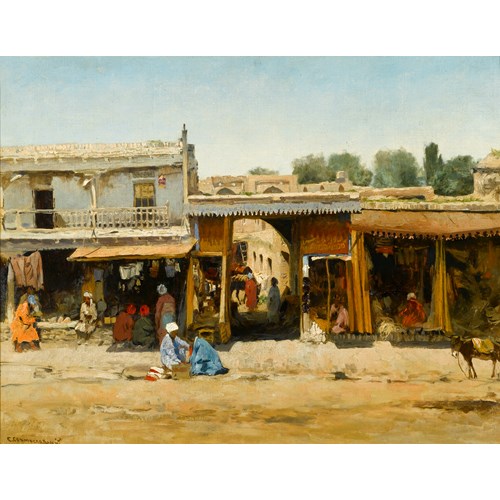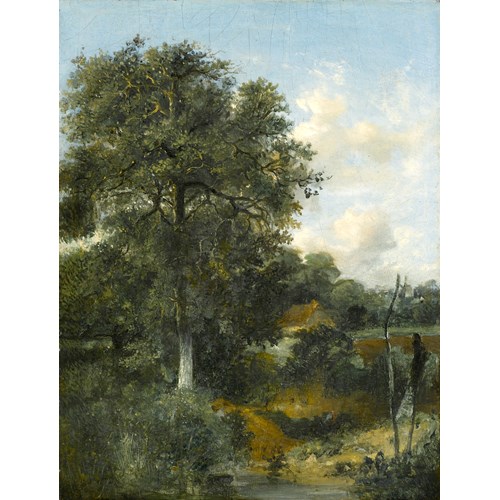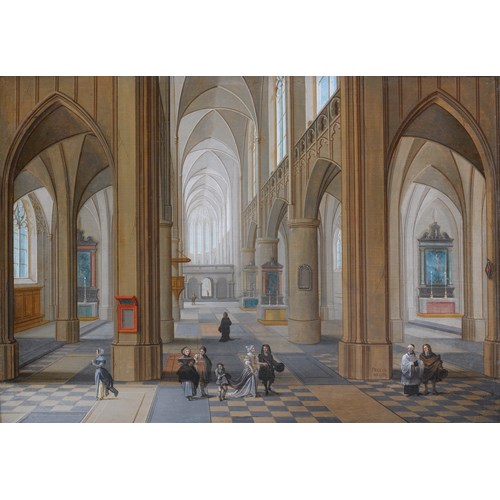Marketplace
The Russian Army Mobilising Behind an Observation Balloon
Count Matteo Lovatti
The Russian Army Mobilising Behind an Observation Balloon
Epoque 1850-1900, 19th century
Origine Italy
Medium Oil on canvas
Dimension 56 x 79.5 cm (22 x 31¹/₄ inches)
The sheer numbers of soldiers riding across the vast landscape is overwhelming in this work. The figures are blurred and blend into the distance, thus the force and power of the Russian army is communicated, working en masse. Ahead of the troops an observation balloon floats in the distance. Count Matteo Lovatti II’s work depicts the Russian Army mobilising on the eve of The Great War (1914-1918). The subject can be identified due to the presence of the new flag of the Russian Empire, created ‘for private use’ between 1914 and 1917, which can be seen several times in the picture.
Although this variant of the Russian flag was never made official it was authorised for private use by Tsar Nicholas II (1868-1918) during The Great War, adding the Romanov eagle on a yellow field in a canton in the top left-hand corner. The conventional Russian flag has changed its form throughout history; it was first used as a naval ensign for merchant and war ships and only became official in 1896. Possibly based on the Dutch tricolour, the flag continued to be used by the Russian Provisional Government even after Nicholas II was thrown from power in the February Revolution of 1917, and it was not replaced until the October Revolution later that year. From that time onwards a red flag charged with communist symbols was adopted instead of the tricolour. It was not until the collapse of the Soviet Union in 1991 that the tricolour was brought back as the official flag of the new Russian Federation.
At the beginning of The Great War the Russians mobilised fielding 114 infantry and 36 cavalry divisions in what was called the ‘steamroller’, indeed it may be this formation which is depicted here in Lovatti’s work. An observation balloon, used for intelligence gathering and artillery spotting, can also be seen on the right-hand corner of the composition. The first time an aerial navigation device was used with absolute certainty was in sea-borne warfare at the Bay of Biscay in 1806. Although, Russian claims exist that a manned hot air balloon flight took place in November, 1731 when, allegedly, a Mr Kriakoutny flew a balloon made of ox-hides from Ryazan town square and landed in the church bell tower, where he was, apparently, beaten by superstitious peasants.
Experimentation with balloons was a feature of the work of the French engineers Jaques-Étienne (1745-1799) and Joseph Mitchel de Montgolfier (1740-1810) who, after years experimenting, launched their first public demonstration of a ballon in flight on 4 June, 1783. It was a decade later that a balloon was to become used for the first time as a military device. In 1794 a decree of the Revolutionary France’s Committee of Public Safety created the world’s very first ‘air force’, called the Compagnie d’Aerostiers. The force was able to launch a balloon for the first time in the history of warfare during a border fight with the Austrians on 2 June, 1794, at the siege of Maubeuge. Thus the balloon and warfare now had a definite future and their destinies would be entwined for several centuries.
Lovatti, born in 1861, was from an aristocratic Roman family, and inherited his love of art from his father who was an architect. Lovatti exhibited in his native city of Rome from 1877. The smallest of the family’s many grand residencies, the Villa Lovatti, Rome, is situated in the gardens of the Russian Ambassador’s residence, the Villa Abamelek.
Although this variant of the Russian flag was never made official it was authorised for private use by Tsar Nicholas II (1868-1918) during The Great War, adding the Romanov eagle on a yellow field in a canton in the top left-hand corner. The conventional Russian flag has changed its form throughout history; it was first used as a naval ensign for merchant and war ships and only became official in 1896. Possibly based on the Dutch tricolour, the flag continued to be used by the Russian Provisional Government even after Nicholas II was thrown from power in the February Revolution of 1917, and it was not replaced until the October Revolution later that year. From that time onwards a red flag charged with communist symbols was adopted instead of the tricolour. It was not until the collapse of the Soviet Union in 1991 that the tricolour was brought back as the official flag of the new Russian Federation.
At the beginning of The Great War the Russians mobilised fielding 114 infantry and 36 cavalry divisions in what was called the ‘steamroller’, indeed it may be this formation which is depicted here in Lovatti’s work. An observation balloon, used for intelligence gathering and artillery spotting, can also be seen on the right-hand corner of the composition. The first time an aerial navigation device was used with absolute certainty was in sea-borne warfare at the Bay of Biscay in 1806. Although, Russian claims exist that a manned hot air balloon flight took place in November, 1731 when, allegedly, a Mr Kriakoutny flew a balloon made of ox-hides from Ryazan town square and landed in the church bell tower, where he was, apparently, beaten by superstitious peasants.
Experimentation with balloons was a feature of the work of the French engineers Jaques-Étienne (1745-1799) and Joseph Mitchel de Montgolfier (1740-1810) who, after years experimenting, launched their first public demonstration of a ballon in flight on 4 June, 1783. It was a decade later that a balloon was to become used for the first time as a military device. In 1794 a decree of the Revolutionary France’s Committee of Public Safety created the world’s very first ‘air force’, called the Compagnie d’Aerostiers. The force was able to launch a balloon for the first time in the history of warfare during a border fight with the Austrians on 2 June, 1794, at the siege of Maubeuge. Thus the balloon and warfare now had a definite future and their destinies would be entwined for several centuries.
Lovatti, born in 1861, was from an aristocratic Roman family, and inherited his love of art from his father who was an architect. Lovatti exhibited in his native city of Rome from 1877. The smallest of the family’s many grand residencies, the Villa Lovatti, Rome, is situated in the gardens of the Russian Ambassador’s residence, the Villa Abamelek.
Epoque: 1850-1900, 19th century
Origine: Italy
Medium: Oil on canvas
Signature: Signed 'M Lovatti' (lower right)
Dimension: 56 x 79.5 cm (22 x 31¹/₄ inches)
Provenance: Sotheby's, London, 15 June 1995, lot 135.
Exhibition: Probably London, Fine Art Society, Catalogue of War Pictures in Various Lands by Matteo Lovatti, October 1917, no. 1., Cossacks.
Plus d'œuvres d'art de la Galerie









